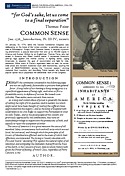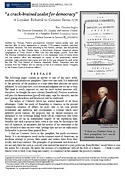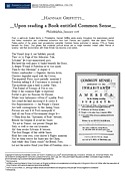REBELLION: 1775-1776
7. Common Sense?
- Thomas Paine, Common Sense, 1776, selections PDF
- Praise for Common Sense in American newspapers, 1776 PDF
- A Loyalist responds to Common Sense: Rev. Charles Inglis, The Deceiver Unmasked, 1776, selections PDF
- A poem on Common Sense: Hannah Griffitts, "Upon reading a Book entitled Common Sense," 1776 PDF
- John Adams looks back on Common Sense, Autobiography, early 1800s, selection PDF





On January 10, 1776, while the Second Continental Congress was deliberating on the future of the "united colonies," a 46-page pamphlet was put out for sale. Simply titled Common Sense, it became a publishing phenomenon, a best-seller in its time. The first printing sold out in two weeks and over 150,000 copies were sold throughout America and Europe. Written by Thomas Paine, an unknown Englishman who had emigrated only fifteen months earlier, it burst upon the scene like a meteor—a "disastrous meteor," wrote John Adams, who felt Paine's inflammatory call for independence would undermine the deliberative work of the Continental Congress. While Paine's basic message—abandon the goal of reconciliation and declare independence—was not new, he went much further. Reject British heritage, condemn monarchy, embrace democracy, enlighten the world. This doesn't sound very revolutionary to us, but it was. "We have it in our power," insisted Paine, "to begin the world all over again."
Yet Paine's major impact came not from being inspirational, but from being angry. "The point to remember," writes literary historian Robert Ferguson, "is that Paine's natural and intended audience is the American mob. . . . He uses anger, the natural emotion of the mob, to let the most active groups find themselves in the general will of a republican citizenry."1 Before Paine, adds Ferguson, the rhetoric of published discourse had been moderate; educated men wrote civilly for publication and kept their fury for private letters and diaries. Then came Paine, calling Britain an "open enemy," denouncing George III as "Royal Brute of England," and mocking the prospect of reconciliation as "truly farcical" and "a fallacious dream." To think otherwise, he charges, is "repugnant to reason." Here we examine Common Sense and the independent spirit it spurred among the "common people," the contempt it received from Loyalists, and the anxiety it caused Patriot leaders.
Thomas Paine, Common Sense, 1776, selections. Only two years after he arrived in the colonies from Britain, Thomas Paine—a former corsetmaker, school master, and tax officer—expressed America's pent-up rage against the mother country in Common Sense, the most influential pamphlet of the Revolutionary period. Paine challenged Americans' longheld pride in Britain and urged them to see what was already the case—they were separate, self-governing, and capable of defeating Britain in war. He presented his argument in four sections. (1) The English constitution you worship? It's a sham. (2) The monarchy you revere as an institution? It doesn't care about you; it cares about Britain's wealth, and a series of "crowned ruffians" has laid the world "in blood and ashes." (3) America today? It is folly to think that it can remain subject to a distant tyrant, and it is self-sabotage to keep pursuing reconciliation, which would surely lead to the "ruin of the continent." (4) Can we win this war? Absolutely, so get going! If we delay it, it will be that much harder to achieve. Here we read excerpts from Parts III and IV of Common Sense. How does Paine's rhetoric work to convey the certainty of his position? To hear Paine's incendiary message within the eighteenth-century language, read Common Sense aloud, with dramatic flourish. (11 pp.)
Praise for Common Sense in American newspapers, 1776. From American newspapers come these seven brief statements of praise for Paine's call to arms. What evidence is presented of its acclaim? How are its opponents acknowledged and rebuffed? What signals the wide approval of the "common people" and their awareness that Patriot leaders may not share their enthusiasm? (2 pp.)
A Loyalist responds to Common Sense: Rev. Charles Inglis, The Deceiver Unmasked, 1776, selections. Horrified by Common Sense, several Loyalists published immediate rebuttals, including Plain Truth by James Chalmers and The Deceiver Unmasked, penned by Rev. Charles Inglis, a British-born Anglican clergyman whose congregation at Trinity Church in New York City was largely Loyalist. Soon after The Deceiver Unmasked was advertised in a city newspaper, Sons of Liberty broke into the printer's office and destroyed all copies of the provocatively named pamphlet. Inglis published new copies and later in the year released his work under the title The True Interest of America Impartially Stated. Presented here are excerpts from his Preface and his rebuttal to Part III of Common Sense. How does he refute Paine's specific arguments? How does he answer Paine's certainty that independence is the only valid option for America's future? (6 pp.)
A poem on Common Sense: Hannah Griffitts, "Upon reading a Book entitled Common Sense," 1776. From a well-to-do Quaker family in Philadelphia, Hannah Griffitts wrote poetry throughout the revolutionary period which hailed moderation and condemned extremism from both Patriots and Loyalists. Indicting Paine as a "Snake beneath the Grass," she grieves that moderate political voices are no longer tolerated—indeed condemned as "friends of tyranny"—and that reconciliation with Great Britain has become a lost option. To whom does she address the poem and warn "to beware the fatal Danger of this subtle Snare"? (1 p.)
John Adams looks back on Common Sense, Autobiography, early 1800s, selection. When Common Sense appeared, John Adams was a delegate to the Second Continental Congress in Philadelphia. In his autobiography, written a quarter century later, he described his response to the pamphlet and its startling popularity. Common Sense burst upon the scene like a "disastrous meteor" that would undermine the deliberative work of the Congress. "I dreaded the effect so popular a pamphlet might have among the people," he wrote to his wife Abigail, "and determined to do all in my Power to counteract the effect of it." One counter-action he took was to publish an anonymous rebuttal entitled Thoughts on Government (see Supplemental Sites). Why would Adams, who agreed that independence was inevitable, react with such dismay to Paine's pamphlet? How did he convey his concern to Paine directly? How did Paine respond? In the early 1800s, how did Adams characterize the pamphlet's ultimate influence on the Revolution? (3 pp.)
Discussion Questions
- From these documents, describe the atmosphere into which Common Sense appeared. How did Paine use the moment to frame his pamphlet and drive across his points?
- What was happening in January 1776, politically and militarily? How did Paine create a sense of urgency to inspire his readers?
- What specific arguments does he give to convince his readers that (1) their pride in British heritage is misguided, (2) the colonies must declare immediate independence, (3) they will be able to defend themselves in war?
- What is Paine's rhetorical strategy in the opening paragraph of Pt. III, "Thoughts on the Present State of American Affairs"? How does he envision his reader?
- What portions of Common Sense would have resonated with the common man in America? with those who were undecided or remained outside the debate?
- Contrast the language of Common Sense with that of the Patriot leadership in earlier publications. How was Paine's message distinctively different for the times?
- In what ways did Paine shape his arguments to appeal to men?
- How does he appeal to his readers' concern for their children and their future?
- Why did Paine choose such similes as the following: disunion is "like a name engraved with the point of a pin on the tender rind of a young oak; the wound will enlarge with the tree"; "All plans, proposals . . . prior to the nineteenth of April . . . are like the almanacs of the last year."
- In the newspaper accounts of praise for Common Sense, what evidence is presented of its acclaim? How are its opponents acknowledged and rebuffed?
- In the accounts, what signals the wide approval of the "common people" and their awareness that Patriot leaders may not share their enthusiasm?
- Overall, what is Charles Inglis's main objections to Paine's arguments, his use of history, and his rhetorical devices?
- What does Inglis's rhetoric say about his motivation and message?
- Why does Inglis call Paine a "crack-brained zealot for democracy" whose work is a model of "uncommon frenzy"? Does Inglis rise above Paine's frenzy?
- Inglis's audience for The Deceiver Unmasked is his fellow Loyalists. Retitle Deceiver and rewrite a few paragraphs to address it to Paine's supporters instead.
- Why did Adams call Paine a 'disastrous meteor' despite his agreement that America should declare independence?
- Describe the meeting of Adams and Paine in spring 1776, shortly after Adams published his anonymous rebuttal, Thoughts on Government. What were Adams's main concerns with Paine as a person? as a political propagandist?
- How do Inglis and Adams agree in their criticism of Common Sense? Where would they disagree?
- What are Hannah Griffitts's message and intended audience in her poem? In what ways does she agree with Inglis? with Adams?
- What is the fate of a man of moderation, according to Griffitts? Who has replaced the moderate voice in public discourse? What other commentators stress this development as a great danger of the times?
- Compose a discussion between Paine and Inglis (perhaps moderated by John Adams) in the mid 1780s, after the treaty ending the Revolution but before the writing of the U.S. Constitution. Do research to learn the situations of the three men at the time.
Framing Questions
- What rebellions and "civil wars" occurred within the colonies as war approached in the mid 1770s?
- How did colonists express and debate their differing opinions?
- How did they deal with political opponents?
- What caused the moderate voice to fade from the political arena?
- What led Americans to support or oppose the ultimate goal of independence?
Printing
Thomas Paine, Common Sense, selectionsPraise for Common Sense (news accounts)
Inglis, The Deceiver Unmasked, selections
Griffitts, "Upon reading a Book Entitled Common Sense"
John Adams on Common Sense
TOTAL
11 pp.
2 pp.
6 pp.
1 pp.
3 pp.
23 pp.
Supplemental Sites
Thomas Paine, overview (BBC)
Thomas Paine: The Radical Founding Father (National Portrait Gallery/Smithsonian)
Rev. Charles Inglis, biography (Dictionary of Canadian Biography Online, University of Toronto)
John Adams, Thoughts on Government, 1776 (The Founders' Constitution, University of Chicago Press)
Adams Family Papers: An Electronic Archive (Massachusetts Historical Society)
Liberty!: The American Revolution (PBS)
- – The World in 1776 (Global Village)
- – The Road to Revolution (Q&A game)
Teaching the Revolution, valuable overview essay by Prof. Carol Berkin, Baruch College (CUNY)
General Online Resources
1Robert A. Ferguson, The American Enlightenment, 1750-1820 (Harvard University Press, 1994; paper ed., 1997), p. 113.
Images:
– Title pages of Thomas Paine, Common Sense, 1776, in English and German. Courtesy of the American Antiquarian Society. Digital images accessed through Early American Imprints, Docs. 43120 & 14963, American Antiquarian Society with Readex/NewsBank.
– Title page of Charles Inglis, The Deceiver Unmasked, publication, 1776. Reproduced by permission of the New-York Historical Society. Digital image accessed through Early American Imprints, Doc. 43050, American Antiquarian Society with Readex/NewsBank.
– Portrait of Thomas Paine, lithograph by Henry John Bufford, ca. 1850, courtesy of the New York Public Library, EM 2937.
– Portrait of Rev. Charles Inglis, oil on canvas by Richard Field, 1810. National Portrait Gallery, UK; given by the sitter's grandson, Thomas Cochran Inglis, 1895. NPG 1023. Reproduced by permission.
Banner image: Original Declaration of Independence, parchment, 1776 (detail); on exhibit in the Rotunda of the National Archives, Washington, DC. Courtesy of the U.S. National Archives and Records Administration.
*PDF file - You will need software on your computer that allows you to read and print Portable Document Format (PDF) files, such as Adobe Acrobat Reader. If you do not have this software, you may download it FREE from Adobe's Web site.



